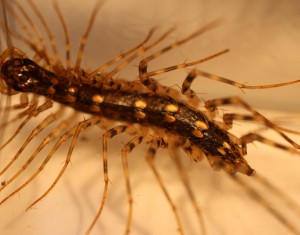
What is this creature!? Where is it from? Is it dangerous?
Head of the House Centipede.
This interesting creature is the House Centipede (Scutigera coleoptrata). They are normally found outdoors and live under rocks, in stacks of wood, and in compost piles. However they will live in houses and are often seen at this time of year when cooler weather forces them indoors. I found three just last week in our collections building!
Of the approximately 600 species of spiders in Ohio only two groups of spiders are potentially harmful to humans, the black widows and the recluse spiders. These spiders are not common in Ohio, and bites from these species are very rare. Many small wounds due to a variety of other causes are often misdiagnosed as spider bites.
So even though the House Centipede is a small centipede and its bite cannot puncture human skin, it still often evokes fear and loathing. The larger cousins of the House Centipede, found in the southern and southwestern United States, can inflict a painful bee sting-like bite, but there is a lack of substantiated reports in the medical literature that centipede bites are fatal to humans. So why then do we fear the lowly House Centipede!? It is thought that the combination of their numerous legs all moving together and the fact that they can move so fast, almost 1.5 feet per second, darting from the shadows towards our feet, that causes a natural apprehension.
Now that we have the emotional response out of the way, let’s look at the facts. The House Centipede is a native of the Mediterranean region of Europe and was first recorded in the eastern United States in the mid-19th Century. It was firmly entrenched in Ohio by the early 20th Century and is described in the 1928 publication The Millipedes and Centipedes of Ohio (Ohio Biol. Survey 4(3), Bulletin 18). The House Centipede is a member of a group of centipedes that have retained their original compound eyes, which are similar to the eyes of insects, and this gives them great vision to track down their prey. Other groups of centipedes have lost their compound eyes due to a more burrowing lifestyle. Every ecosystem needs its predator species, and centipedes are among the largest terrestrial invertebrate predators. In our houses they feed on a variety of arthropods including cockroaches, termites, ants, silverfish, and spiders. Kinda makes you appreciate them now, right!? Natures own pest control, a large terrestrial invertebrate predator, scouring your house and getting rid of unwanted pest species!
By the way, even though the name implies it, “centi”-pedes usually don’t have 100 legs. The House Centipede grows to a maximum of 15 pairs of legs. Other centipedes in the world range from less than 20 legs to over 300. I guess the House Centipede just looks like it has 100 legs as it scurries rapidly towards your feet!